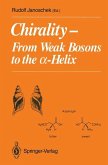Shinsaku Fujita
Symmetry and Combinatorial Enumeration in Chemistry
Shinsaku Fujita
Symmetry and Combinatorial Enumeration in Chemistry
- Broschiertes Buch
- Merkliste
- Auf die Merkliste
- Bewerten Bewerten
- Teilen
- Produkt teilen
- Produkterinnerung
- Produkterinnerung
Mit der Gruppentheorie führt der Autor Chemiestudenten in die Stereochemie ein. Er erklärt einheitlich und sehr verständlich stereochemische Probleme und die Methode der Abzählung chemischer Isomere.
Andere Kunden interessierten sich auch für
![Kekulé Structures in Benzenoid Hydrocarbons Kekulé Structures in Benzenoid Hydrocarbons]() Sven J. CyvinKekulé Structures in Benzenoid Hydrocarbons41,99 €
Sven J. CyvinKekulé Structures in Benzenoid Hydrocarbons41,99 €![Chirality Chirality]() Chirality39,99 €
Chirality39,99 €![Organotin Compounds Organotin Compounds]() Organotin Compounds41,99 €
Organotin Compounds41,99 €![Stereodirected Synthesis with Organoboranes Stereodirected Synthesis with Organoboranes]() Donald S. MattesonStereodirected Synthesis with Organoboranes38,99 €
Donald S. MattesonStereodirected Synthesis with Organoboranes38,99 €![Metalorganic Catalysts for Synthesis and Polymerization Metalorganic Catalysts for Synthesis and Polymerization]() Metalorganic Catalysts for Synthesis and Polymerization113,99 €
Metalorganic Catalysts for Synthesis and Polymerization113,99 €![Design and Synthesis of Organic Molecules Based on Molecular Recognition Design and Synthesis of Organic Molecules Based on Molecular Recognition]() Design and Synthesis of Organic Molecules Based on Molecular Recognition81,99 €
Design and Synthesis of Organic Molecules Based on Molecular Recognition81,99 €![New Frontiers in Polymer Synthesis New Frontiers in Polymer Synthesis]() Shiro Kobayashi (Volume ed.)New Frontiers in Polymer Synthesis149,99 €
Shiro Kobayashi (Volume ed.)New Frontiers in Polymer Synthesis149,99 €-
-
-
Mit der Gruppentheorie führt der Autor Chemiestudenten in die Stereochemie ein. Er erklärt einheitlich und sehr verständlich stereochemische Probleme und die Methode der Abzählung chemischer Isomere.
Hinweis: Dieser Artikel kann nur an eine deutsche Lieferadresse ausgeliefert werden.
Hinweis: Dieser Artikel kann nur an eine deutsche Lieferadresse ausgeliefert werden.
Produktdetails
- Produktdetails
- Verlag: Springer / Springer Berlin Heidelberg / Springer, Berlin
- Artikelnr. des Verlages: 978-3-540-54126-4
- 1991.
- Seitenzahl: 384
- Erscheinungstermin: 5. September 1991
- Englisch
- Abmessung: 235mm x 155mm x 21mm
- Gewicht: 560g
- ISBN-13: 9783540541264
- ISBN-10: 3540541268
- Artikelnr.: 26384216
- Herstellerkennzeichnung Die Herstellerinformationen sind derzeit nicht verfügbar.
- Verlag: Springer / Springer Berlin Heidelberg / Springer, Berlin
- Artikelnr. des Verlages: 978-3-540-54126-4
- 1991.
- Seitenzahl: 384
- Erscheinungstermin: 5. September 1991
- Englisch
- Abmessung: 235mm x 155mm x 21mm
- Gewicht: 560g
- ISBN-13: 9783540541264
- ISBN-10: 3540541268
- Artikelnr.: 26384216
- Herstellerkennzeichnung Die Herstellerinformationen sind derzeit nicht verfügbar.
1 Introduction.- 2 Symmetry and Point Groups.- 2.1 Symmetry Operations and Elements.- 2.2 Conjugacy Glasses in Point Groups.- 2.3 Subgroups of Point Groups.- 2.4 Conjugate and Normal Subgroups of Point Groups.- 2.5 Non-Redundant Set of Subgroups for a Point Group.- 3 Permutation Groups.- 3.1 Permutations and Cycles.- 3.2 Permutation Groups.- 3.3 Transitivity and Orbits..- 3.4 Symmetric Groups.- 3.5 Parity.- 3.6 Alternating Groups.- 4 Axioms and Theorems of Group Theory.- 4.1 Axioms and Multiplication Tables.- 4.2 Subgroups.- 4.3 Cosets.- 4.4 Equivalence Relations.- 4.5 Conjugacy Classes.- 4.6 Conjugate and Normal Subgroups.- 4.7 Subgroup Lattices.- 4.8 Cyclic Groups.- 5 Coset Representations and Orbits.- 5.1 Coset Representations.- 5.2 Transitive Permutation Representations.- 5.3 Mark Tables.- 5.4 Permutation Representations and Orbits.- 6 Systematic Classification of Molecular Symmetries.- 6.1 Assignment of Coset Representations to Orbits.- 6.2 SCR Notation.- 7 Local Symmetries and Forbidden Coset Representations.- 7.1 Blocks and Local Symmetries.- 7.2 Forbidden Coset Representations.- 8 Chirality Fittingness of an Orbit.- 8.1 Ligands.- 8.2 Behavior of Cosets on the Action of a CR.- 8.3 Chirality Fittingness of an Orbit.- 9 Subduction of Coset Representations.- 9.1 Subduction of Coset Representations.- 9.2 Subduced Mark Table.- 9.3 Chemical Meaning of Subduction.- 9.4 Unit Subduced Cycle Indices.- 9.5 Unit Subduced Cycle Indices with Chirality Fittingness.- 9.6 Desymmetrization Lattice.- 10 Prochirality.- 10.1 Desymmetrization of Enantiospheric Orbits.- 10.2 Prochirality.- 10.3 Further Desymmetrization of Enantiospheric Orbits.- 10.4 Chiral syntheses.- 11 Desymmetrization of Para-Achiral Compounds.- 11.1 Chiral Subduction of Homospheric Orbits.- 11.2 Desymmetrization of Homospheric Orbits.- 11.3 Chemoselective and Stereoselective Processes.- 12 Topicity and Stereogenicity.- 12.1 Topicity Based On Chirality Fittingness of an Orbit.- 12.2 Stereogenicity.- 13 Counting Orbits.- 13.1 The Cauchy-Frobenius Lemma.- 13.2 Configurations.- 13.3 The Pólya-Redfield Theorem.- 14 Obligatory Minimum Valencies.- 14.1 Isomer Enumeration under the OMV Restriction.- 14.2 Unit Cycle Indices.- 15 Compounds with Achiral Ligands Only.- 15.1 Compounds with Given Symmetries.- 15.2 Compounds with Given Symmetries and Weight.- 16 New Cycle Index.- 16.1 New Cycle Indices Based On USCIs.- 16.2 Correlation of New Cycle Indices to Pólya's Theorem.- 16.3 Partial Cycle Indices.- 17 Cage-Shaped Molecules with High Symmetries.- 17.1 Edge Strategy.- 17.2 Tricyclodecanes with Td and Its Subsymmetries.- 17.3 Use of Another Ligand-Inventory.- 17.4 New Type of Cycle Index.- 18 Elementary Superposition.- 18.1 The USCI Approach.- 18.2 Elementary Superposition.- 18.3 Superposition for Other Indices.- 19 Compounds with Achiral and Chiral Ligands.- 19.1 Compounds with Given Symmetries.- 19.2 Compounds with Given Symmetries and Weights.- 19.3 Compounds with Given Weights.- 19.4 Special Cases.- 19.5 Other Indices.- 20 Compounds with Rotatable Ligands.- 20.1 Rigid Skeleton and Rotatable Ligands.- 20.2 Enumeration of Rotatable Ligands.- 20.3 Enumeration of Non-Rigid Isomers.- 20.4 Total Numbers.- 20.5 Typical Procedure for Enumeration.- 21 Promolecules.- 21.1 Molecular Models.- 21.2 Proligands and Promolecules.- 21.3 Enumeration of Promolecules.- 21.4 Molecules Based on Promolecules.- 21.5 Prochiralities of Promolecules and Molecules.- 21.6 Concluding Remarks.- 22 Appendix A. Mark Tables.- A.1 Td Point Group and Its Subgroups.- A. 2 D3h Point Group and Its Subgroups.- 23Appendix B. Inverses of Mark Tables.- B. 1 Td Point Group and Its Subgroups.- B. 2 D3h Point Group and Its Subgroups.- 24 Appendix C. Subduction Tables.- C. 1 Td Point Group and Its Subgroups.- C. 2 D3h Point Group and Its Subgroups.- 25 Appendix D. Tables of USCIs.- D. 1 Td Point Group and Its Subgroups.- D. 2 D3h Point Group and Its Subgroups.- 26 Appendix E. Tables of USCI-CFs.- E. 1 Td Point Group and Its Subgroups.- E.2 D3h Point Group and Its Subgroups.- 27 Index.
1 Introduction.- 2 Symmetry and Point Groups.- 2.1 Symmetry Operations and Elements.- 2.2 Conjugacy Glasses in Point Groups.- 2.3 Subgroups of Point Groups.- 2.4 Conjugate and Normal Subgroups of Point Groups.- 2.5 Non-Redundant Set of Subgroups for a Point Group.- 3 Permutation Groups.- 3.1 Permutations and Cycles.- 3.2 Permutation Groups.- 3.3 Transitivity and Orbits..- 3.4 Symmetric Groups.- 3.5 Parity.- 3.6 Alternating Groups.- 4 Axioms and Theorems of Group Theory.- 4.1 Axioms and Multiplication Tables.- 4.2 Subgroups.- 4.3 Cosets.- 4.4 Equivalence Relations.- 4.5 Conjugacy Classes.- 4.6 Conjugate and Normal Subgroups.- 4.7 Subgroup Lattices.- 4.8 Cyclic Groups.- 5 Coset Representations and Orbits.- 5.1 Coset Representations.- 5.2 Transitive Permutation Representations.- 5.3 Mark Tables.- 5.4 Permutation Representations and Orbits.- 6 Systematic Classification of Molecular Symmetries.- 6.1 Assignment of Coset Representations to Orbits.- 6.2 SCR Notation.- 7 Local Symmetries and Forbidden Coset Representations.- 7.1 Blocks and Local Symmetries.- 7.2 Forbidden Coset Representations.- 8 Chirality Fittingness of an Orbit.- 8.1 Ligands.- 8.2 Behavior of Cosets on the Action of a CR.- 8.3 Chirality Fittingness of an Orbit.- 9 Subduction of Coset Representations.- 9.1 Subduction of Coset Representations.- 9.2 Subduced Mark Table.- 9.3 Chemical Meaning of Subduction.- 9.4 Unit Subduced Cycle Indices.- 9.5 Unit Subduced Cycle Indices with Chirality Fittingness.- 9.6 Desymmetrization Lattice.- 10 Prochirality.- 10.1 Desymmetrization of Enantiospheric Orbits.- 10.2 Prochirality.- 10.3 Further Desymmetrization of Enantiospheric Orbits.- 10.4 Chiral syntheses.- 11 Desymmetrization of Para-Achiral Compounds.- 11.1 Chiral Subduction of Homospheric Orbits.- 11.2 Desymmetrization of Homospheric Orbits.- 11.3 Chemoselective and Stereoselective Processes.- 12 Topicity and Stereogenicity.- 12.1 Topicity Based On Chirality Fittingness of an Orbit.- 12.2 Stereogenicity.- 13 Counting Orbits.- 13.1 The Cauchy-Frobenius Lemma.- 13.2 Configurations.- 13.3 The Pólya-Redfield Theorem.- 14 Obligatory Minimum Valencies.- 14.1 Isomer Enumeration under the OMV Restriction.- 14.2 Unit Cycle Indices.- 15 Compounds with Achiral Ligands Only.- 15.1 Compounds with Given Symmetries.- 15.2 Compounds with Given Symmetries and Weight.- 16 New Cycle Index.- 16.1 New Cycle Indices Based On USCIs.- 16.2 Correlation of New Cycle Indices to Pólya's Theorem.- 16.3 Partial Cycle Indices.- 17 Cage-Shaped Molecules with High Symmetries.- 17.1 Edge Strategy.- 17.2 Tricyclodecanes with Td and Its Subsymmetries.- 17.3 Use of Another Ligand-Inventory.- 17.4 New Type of Cycle Index.- 18 Elementary Superposition.- 18.1 The USCI Approach.- 18.2 Elementary Superposition.- 18.3 Superposition for Other Indices.- 19 Compounds with Achiral and Chiral Ligands.- 19.1 Compounds with Given Symmetries.- 19.2 Compounds with Given Symmetries and Weights.- 19.3 Compounds with Given Weights.- 19.4 Special Cases.- 19.5 Other Indices.- 20 Compounds with Rotatable Ligands.- 20.1 Rigid Skeleton and Rotatable Ligands.- 20.2 Enumeration of Rotatable Ligands.- 20.3 Enumeration of Non-Rigid Isomers.- 20.4 Total Numbers.- 20.5 Typical Procedure for Enumeration.- 21 Promolecules.- 21.1 Molecular Models.- 21.2 Proligands and Promolecules.- 21.3 Enumeration of Promolecules.- 21.4 Molecules Based on Promolecules.- 21.5 Prochiralities of Promolecules and Molecules.- 21.6 Concluding Remarks.- 22 Appendix A. Mark Tables.- A.1 Td Point Group and Its Subgroups.- A. 2 D3h Point Group and Its Subgroups.- 23Appendix B. Inverses of Mark Tables.- B. 1 Td Point Group and Its Subgroups.- B. 2 D3h Point Group and Its Subgroups.- 24 Appendix C. Subduction Tables.- C. 1 Td Point Group and Its Subgroups.- C. 2 D3h Point Group and Its Subgroups.- 25 Appendix D. Tables of USCIs.- D. 1 Td Point Group and Its Subgroups.- D. 2 D3h Point Group and Its Subgroups.- 26 Appendix E. Tables of USCI-CFs.- E. 1 Td Point Group and Its Subgroups.- E.2 D3h Point Group and Its Subgroups.- 27 Index.








